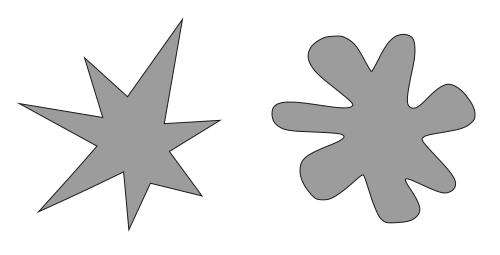English: In a psychological experiment first designed by Wolfgang Köhler, people are asked to choose which of these shapes is named Bouba and which is named Kiki. 95% to 98% of people choose Kiki for the angular shape and Booba for the rounded shape.
It is thought that this has implications for language development, in that the naming of objects is not completely arbitrary. The rounded shape may most commonly be named Booba because the mouth makes a more rounded shape to produce that sound. Similarly a more taut, angular mouth shape is needed to make the sound Kiki. The sounds of a K are harder and more forceful than those of a B, as well.
Note also that, in the Roman alphabet, the angular shape mimics the angular letters K and I, while the rounded shape mimics the rounded letters B and O.
The kiki visual shape has a sharp inflection and the sound ‘kiki’ represented in your auditory cortex, in the hearing centers of your brain, also has a sharp sudden inflection. Your brain performs a cross-modal synesthetic abstraction, recognizing that common property of jaggedness, extracting it, and so reaching the conclusion that they are both kiki. — V. S. Ramachandran.
Español: En un experimento psicológico ideado por Wolfgang Köhler, se pide al sujeto que diga cuál de estas figuras se llama Booba y cuál Kiki. Del 95% al 98% de la gente le asigna el nombre Kiki a la figura angular naranja y Booba a la figura redondeada violeta.
Se piensa que esto tiene implicaciones en el desarrollo del lenguaje; es decir, que el mecanismo de poner nombres a los objetos no es totalmente arbitrario. Otra explicación sería que la forma redondeada suele recibir el nombre de Booba porque los labios forman una figura redondeada para producir el sonido. En cambio, los labios forman una figura más angulosa al pronunciar Kiki. Además, el sonido de las K es más forzado que el de las B.
Por otra parte, en el alfabeto romano, las letras B, o y a tienen una forma más redondeada que K e i.
Italiano: In un esperimento psicologico ideato da Wolfgang Köhler, viene chiesto ad un gruppo di persone di decidere a quale di queste due immagini assegnare il nome 'Booba (leggi buba) e a quale Kiki. Dal 95% al 98% delle persone scelgono Kiki per la figura con gli spigoli, Booba per quella tondeggiante.
Si pensa che questo abbia implicazioni per lo sviluppo del linguaggio, infatti i nomi scelti per le cose non sono frutto di una decisione arbitraria ma di somiglianze (fisiche ecc.) La figura tondeggiante è spesso chiamata Booba perché questa parola fa sì che le labbra formino un'apertura circolare. Allo stesso modo a more taut, angular mouth shape is needed to make the sound Kiki. Il suono della K è più duro e forzato di quello della B, appunto.
Da notare anche che nell'alfabeto romano la K e la I abbiano una forma piena di linee intersecate che formano spigoli, mentre la B e la O sono forme tondeggianti.
עברית: בניסוי פסיכולוגי אשר תוכנן לראשונה על ידי וולפגנג קוהלר, אנשים מתבקשים להחליט לאיזו מן הצורות קוראים "בובה" ולאיזו קוראים "קיקי".95% - 98% מהאנשים בוחרים בכינוי קיקי עבור הצורה הכתומה הזוויתית ובכינוי בובה עבור הצורה הסגולה המעוגלת.
סוברים שיש לכך השלכות על התפתחות שפות, בכך שקריאת שמות לעצמים אינה שרירותית לחלוטין. הצורה המעוגלת עשויה להתכנות בדרך כלל בובה מכיוון שהפה יוצר צורה מעוגלת יותר כדי להפיק את הצליל. בדומה לכך, יש צורך בצורת פה יותר מתוחה וזוויתית כדי להפיק את הצליל קיקי.כמו-כן הצלילים של ק' קשים וחזקים יותר מאשר אלה של ב'.
יש לשים לב גם לכך שבאלפבית הלטיני הצורה הזוויתית דומה לאותיות הזוויתיות K ו-I, בעוד שהצורה המעוגלת דומה לאותיות המעוגלות B ו- O.
לצורה הגרפית קיקי יש כיפופים חדים פתאומיים, ולצליל קיקי המיוצג בקורטקס השמיעתי, במרכזי השמיעה במוח, יש גם כן כיפופים חדים פתאומיים. המוח מבצע הפשטה סינסתטית של מיזוג חושים, מזהה את התכונה המשותפת של זוויתיות, וכך מגיע למסקנה שהם שניהם קיקי - ויליאנור ס' רמצ'נדרן
Deutsch: In einem psychologischen Experiment, entwickelt von Wolfgang Köhler, werden die Probanden aufgefordert zu entscheiden, welche der beiden Formen Booba und welche Kiki heißen solle. 95% bis 98% der Probanden wählen Kiki für die eckige Form und Booba für die runde.
Man meint, dass dies Einfluss auf die Sprachentwicklung hat, indem es zeigt, dass die Namensgebung für Objekte nicht vollkommen zufällig erfolgt. Die runde Form könnte gewöhnlicherweise Booba genannt werden, weil der Mund bei der Lautformung selbst runder wird. Gleichfalls ist ein angespannterer, eckigerer Mund nötig, um Kiki auszusprechen. Der Klang eines Ks ist außerdem härter und kräftiger, als der eines Bs.
Im römischen Alphabet ahmen des Weiteren die eckigen Formen die eckigen Buchstaben K und I nach, währenddessen die runden Formen durch B und O nachgahmt werden. |




